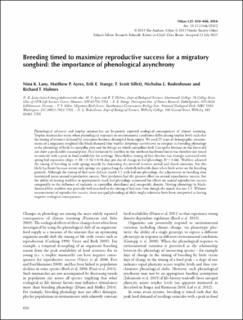| dc.contributor.author | Lany, Nina K. | |
| dc.contributor.author | Ayres, Matthew P. | |
| dc.contributor.author | Stange, Erik | |
| dc.contributor.author | Sillett, T Scott | |
| dc.contributor.author | Rodenhouse, Nicholas L. | |
| dc.contributor.author | Holmes, Richard | |
| dc.date.accessioned | 2023-05-12T13:03:33Z | |
| dc.date.available | 2023-05-12T13:03:33Z | |
| dc.date.created | 2016-08-11T11:34:17Z | |
| dc.date.issued | 2016 | |
| dc.identifier.citation | Oikos. 2016, 125 (5), 656-666. | en_US |
| dc.identifier.issn | 0030-1299 | |
| dc.identifier.uri | https://hdl.handle.net/11250/3067810 | |
| dc.description.abstract | Phenological advances and trophic mismatches are frequently reported ecological consequences of climate warming. Trophic mismatches occur when phenological responses to environmental conditions differ among trophic levels such that the timing of resource demand by consumers becomes decoupled from supply. We used 25 years of demographic measure- ments of a migratory songbird (the black-throated blue warbler Setophaga caerulescens) to compare its breeding phenology to the phenology of both its caterpillar prey and the foliage on which caterpillars feed. Caterpillar biomass in this forest did not show a predictable seasonal pulse. Nest initiation by warblers in this northern hardwood forest was therefore not timed to coincide with a peak in food availability for nestlings. Nonetheless, timing of first clutches was strongly associated with spring leaf expansion (slope SE 0.56 0.08 days per day of change in leaf phenology, R 2 0.66). Warblers adjusted the timing of breeding to early springs mainly by shortening the interval between arrival and clutch initiation, but this likely has limits because recent early springs are approaching the relatively inflexible dates when birds arrive on the breeding grounds. Although the timing of first nests did not match 1:1 with leaf-out phenology, the adjustments in breeding time maximized mean annual reproductive success. Nest predation had the greatest effect on annual reproductive success, but the ability of nesting warblers to appropriately track leaf phenology accounted for effects on annual reproductive success comparable to the influence of variation in caterpillar abundance and conspecific density. Nesting phenology in black- throated blue warblers was generally well matched to the timing of leaf-out, even though the match was not 1:1. Without measurements of reproductive success, these unequal phenological shifts might otherwise have been interpreted as having negative ecological consequences. | en_US |
| dc.language.iso | eng | en_US |
| dc.title | Breeding timed to maximize reproductive success for a migratory songbird: The importance of phenological asynchrony | en_US |
| dc.type | Peer reviewed | en_US |
| dc.type | Journal article | en_US |
| dc.description.version | publishedVersion | en_US |
| dc.rights.holder | © 2015 The Authors | en_US |
| dc.subject.nsi | VDP::Matematikk og Naturvitenskap: 400::Zoologiske og botaniske fag: 480 | en_US |
| dc.source.pagenumber | 656-666 | en_US |
| dc.source.volume | 125 | en_US |
| dc.source.journal | Oikos | en_US |
| dc.source.issue | 5 | en_US |
| dc.identifier.doi | 10.1111/oik.02412 | |
| dc.identifier.cristin | 1372113 | |
| dc.relation.project | Andre: US National Science Foundation | en_US |
| cristin.unitcode | 7511,5,0,0 | |
| cristin.unitname | Lillehammer | |
| cristin.ispublished | true | |
| cristin.fulltext | original | |
| cristin.qualitycode | 1 | |
